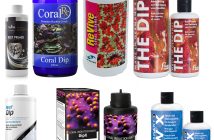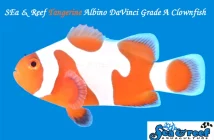
On the AquaNerd blog we typically discuss saltwater aquarium products and marine livestock but our interest has recently expanded into freshwater fish and invertebrates. Below is an article we published on our retail website and we thought it would be a good idea to repost it here in greater detail.
The Cherry Red Shrimp, scientifically known as Neocaridina davidi, is a vibrant and charming freshwater shrimp species that has become a favorite among aquarium enthusiasts. Originating from the freshwater streams of Taiwan, these shrimps have adapted well to aquarium life and are renowned for their striking red coloration and ease of care. In this comprehensive guide, we’ll explore the essential aspects of caring for Cherry Red Shrimp in an aquarium, including setup, diet, compatibility, reproduction, molting, lifespan, insights into their natural behavior, and guidance on caring for their young.
Aquarium Setup: Cherry Red Shrimp are adaptable and can thrive in aquariums of various sizes, starting from 5 gallons. Provide a well-planted tank with hiding spots, moss, and driftwood to mimic their natural habitat. Ensure stable water parameters, including a temperature range of 65-75°F (18-24°C), a pH level between 6.5 and 8.0, and a water hardness of 6-8 dGH.
Water Parameters: Maintaining excellent water quality is crucial for the health of Cherry Red Shrimp. Regular monitoring of ammonia, nitrite, nitrate, and pH levels, along with consistent water changes, will contribute to optimal conditions for these delightful shrimp.
Diet: Cherry Red Shrimp are omnivores and have a straightforward diet. They will happily consume algae, biofilm, and detritus in the aquarium. Supplement their diet with high-quality shrimp pellets like the various types of Dennerle Shrimp King pellet food. In addition pellet food you may also consider feeding small pieces of blanched vegetables such as spinach, zucchini, or cucumber. Providing these shrimp a balanced diet contributes to their vibrant red coloration and overall well-being.
Compatibility: Cherry Red Shrimp are generally peaceful and can coexist with a variety of community fish. Ideal tankmates include small, non-aggressive species such as guppies, tetras, and dwarf rasboras. However, exercise caution with larger or more aggressive fish that may view the shrimp as potential prey. Ensure the aquarium has sufficient hiding spots to give the shrimp a sense of security.
Safe Fish Companions: Cherry Red Shrimp are considered safe with small, peaceful fish that do not have a predatory nature. Some suitable tankmates include:
- Dwarf Gouramis
- Corydoras Catfish
- Otocinclus Catfish
- Endler’s Livebearers
Reproduction: Cherry Red Shrimp are prolific breeders, with adult females typically laying around 20 to 30 eggs in each clutch. The females deposit the eggs beneath their abdomen, and once hatched, the juvenile shrimp are miniature replicas of the adults. Provide sufficient hiding spots for the offspring to enhance their chances of survival. Adult females typically lay eggs every 3 to 4 weeks, and the eggs take approximately 20 to 30 days to hatch, depending on water conditions.
Caring for Young Shrimp: Caring for young Cherry Red Shrimp involves creating a safe environment for their growth. Ensure the tank is well-planted with moss and hiding spots, as the young shrimp will seek refuge. Feed them specialized shrimp fry food or powdered spirulina to ensure they receive the appropriate nutrition. Regular water changes and monitoring water parameters are essential to provide a stable and healthy environment for the young shrimp to thrive.
Molting: Like all shrimp, Cherry Red Shrimp molt to grow. During molting, they shed their exoskeleton, leaving a vulnerable, soft shell. Provide hiding spots and a calcium source, such as crushed coral or specialized shrimp supplements, to aid in the molting process. Avoid handling or disturbing shrimp during this vulnerable time.
Lifespan: Cherry Red Shrimp have a lifespan of around 1 to 2 years under optimal conditions. Providing a well-maintained aquarium with proper nutrition, water quality, and a stress-free environment contributes to their longevity.
In conclusion, Cherry Red Shrimp are delightful and low-maintenance additions to freshwater aquariums with other “shrimp safe” species of fish, plants and other invertebrates. By understanding and meeting their specific care requirements, enthusiasts can enjoy the beauty and charm of these vibrant little shrimp while creating a thriving freshwater aquarium, including the successful care of their offspring.





